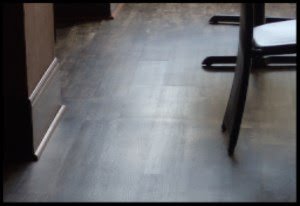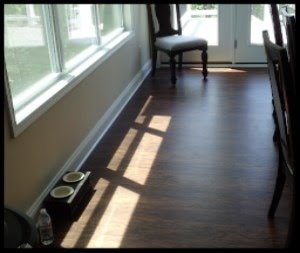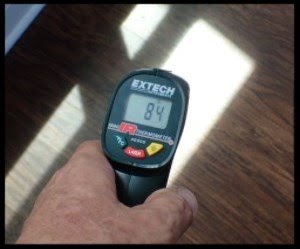LUXURY VINYL MEETS IT'S KRYPTONITE
One year ago I published an article regarding the effect heat has on different floor coverings. The article covered things like friction burns on carpet caused from improper bonnet cleaning and friction burns caused from the brush bars on upright vacuums left in one place for too long. It also covered thermal shock from direct sunlight exposure on ceramic tile causing it to heave off the subfloor. I showed the effect of radiant heat driving moisture out of newly placed concrete into a wood floor causing it to cup and also friction burns on heavily textured luxury vinyl floors where the furniture glide (felt or plastic) only “glides” on the ridges of the texture, not a flat surface. All the above referenced issues were caused by heat, kryptonite so to speak to those floor coverings in one way or another.
In this article I want to focus on the effect direct sunlight exposure is having on luxury vinyl floors, specifically floating, luxury vinyl plank floors. These floors are absolutely incredible and are being sold as a waterproof floor. Water cannot damage it. I have inspected a number of luxury vinyl plank floors that are floating installed over the past year or so and one of the issues I get called in to diagnose is why are the end joints peaking up in specific areas. I am seeing this issue more and more often than ever before, two in the last couple of weeks. My daughter Jessica, who is also my protégé and one of the lead sales associates at a local flooring wholesaler, said we need to write an article on this topic. I agreed and started looking through my archives and found several floors with this concern that I inspected in 2016 and continued to look farther back into 2015 and couldn’t find anything. Guess what, these specific types of products are so new, they weren’t having issues like this yet.
Luxury vinyl has been in the market for a while, starting with Duraceramic and Adura. These glue-down floors had some issues when they first hit the market, but they have been corrected over the years with advancements in technology. The market demand for luxury vinyl has exploded over the last few years so everyone got into the luxury vinyl game. Many carpet-only mills now have luxury vinyl in their product offerings. With the push to hit the market with something new, many of these products are not tried and true as the ones that have been around for a while. Flooring has always been one of those products that is true to the adage “you get what you pay for”.
One of the problems that luxury vinyl has had since its inception is its reaction to heat. Several manufacturers now have disclaimer lines in their installation instructions or warranties that warn against exposure to direct sunlight. While some will give recommendations as to how to prevent issues from occurring, vinyl reacts to temperature changes. It is the nature of the product.
Several manufacturers have realized this and are testing and bringing to market materials that are made more stable to counteract the effect of heat on the flooring. These manufacturers have added stabilizers to the vinyl product to help it take the temperature changes better. These products are new and very few of them are available yet.
I have been inspecting laminate floors since the mid 90’s, when a product called Pergo hit the shores of the US. The biggest issue with laminate floors is water. Water on top or water underneath, makes no difference, the core of the laminate will absorb the water and swell. Water is like kryptonite to these types of products. Not luxury vinyl though, it is impervious to water, water cannot damage it. There is one thing that I am seeing however, which is like kryptonite to floating, luxury vinyl floors – direct sunlight exposure.
In each of the photos above, the floor receives direct sunlight exposure. In nearly all the installation guidelines I have read they specifically state in one way or another, “do not install in locations exposed to direct sunlight”. In the photo to the left, that is doable by simply closing the draperies. Not so much in the photo to the right where the floor is installed in a restaurant that receives sunlight exposure all morning long. I guess you could close a sunscreen of some sort, except the ambiance of the scenery outside is lost.
In the above two photos the floor is installed in a renovated warehouse where the windows letting in the sun are 30 or more feet above the floor. No real easy way to prevent direct sunlight exposure here.
The previous photos were taken in a new home that overlooks some awesome scenery; I doubt the consumers are going to install any draperies or window coverings. The windows and doors are energy efficient, double pane and gas filled, but do nothing to stop the heat of the sunlight passing through based on the readings I was getting on an infrared thermometer.
The temperature of the floor in the areas just inches away from the direct sunlight is 66°F. Whereas in the areas receiving direct sunlight, the temperature of the floor is up to 84°F – 18 degrees different. And the outdoor temperature this day was rather moderate; this was just about 6 weeks ago when it was still rather cool in Ohio.
BOTTOM LINE
So these floating, luxury vinyl, plank floors although waterproof, meet their kryptonite with direct sunlight exposure. Specifiers and designers need to be more aware of this, although I am certain it is only a matter of time that manufacturers will figure out a way to stabilize these products so they are not affected by direct sunlight.
I see a trend and am wondering if it is occurring in just northeast Ohio or is this happening in other parts of the country too. I am seeing a trend of less and less window treatments in different parts of homes. Consumers want to see the sun not block it out, most especially in northeast Ohio. Here we have about 300 days a year where there is some sort of cloud cover. So when the sun is shining, we want to relish AS MUCH OF IT AS WE CAN, not close a blind or drape. There may be some options in the way of films you can put on the windows to diffuse the heat of the sun coming through and there are windows that will block the heat of the sun. However, architects and designers need to be aware of the limitations of the product being installed and the desires of the customer. If the customer does not want window treatments, different windows or something to diffuse the sunlight will be beneficial for the long-term success of the floor.









